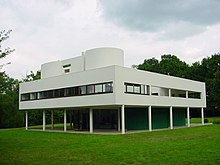
The machine aesthetic "label"[2] is used in architecture and other arts to describe works that either draw the inspiration from industrialization with its mechanized mass production or use elements resembling structures of complex machines (ships, planes, etc.) for the sake of appearance. As an example of the latter, buildings in the International Modernism style frequently used horizontal strips of metal-framed windows crossing the smooth walls to imitate an ocean liner in a deliberate violation of the "truth to materials" principle (as the walls were actually made of bricks).[3]
Machine aesthetic is neither an art style, nor an art movement in itself, but a common trait shared by multiple movements of the first three decades of the 20th century (so called First Machine Age), including French purism, Dutch De Stijl, Russian suprematism and productivism, German constructivism (Bauhaus), and American precisionism.[4] With the notable exception of dadaists, most adherents of machine aesthetic were generally adoring the industrial development, although sometimes with hesitation: "this shouldn't be beautiful, but it is" (Elsie Driggs on her smokestacks- and smoke-filled landscape of Pittsburg steel mills).[2]
At its heyday, machine aesthetic was truly the spirit of the age, Zeitgeist, that affected the mood of artists across movements as diverse as realism, dadaism, and futurism, changing the minds like the (contemporaneous) Jazz Age did.[5]
- ^ Sbriglio 2015, p. 100.
- ^ a b Meecham & Sheldon 2013, p. 140.
- ^ Curl & Wilson 2021, Machine Aesthetic.
- ^ Meecham & Sheldon 2013, pp. 140–141.
- ^ Meecham & Sheldon 2013, pp. 145–146.